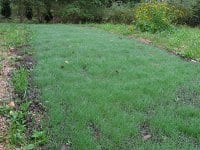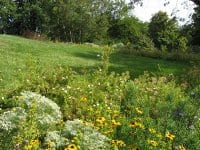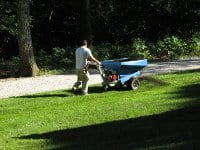A bizarre and wasteful fetish to some, a proud achievement of a caring property owner for others, our modern “boring carpet of green” has become ubiquitous, accepted, and in some circles has even achieved status as an object of envy and desire. How we have come to this point is a long and curious tale of primal urges; 19th-century, English land-use practices; and aggressive marketing from the emerging Lawn Industrial Complex after World War II. But, that’s another story.
As landscaping/land-care/horticulure professionals of one stripe or other, we are often working on, near, or with some amount of turf. We may have to specify it, install it, or care for it. Those of us who like to think we’re plying our trade in a way that embodies caring for the environment have to come to terms with the puzzling set of contradictions that a lawn encompasses. And we have to do it in a market dominated by large, franchised companies; with customer preferences that make it challenging to “do the right thing;” and governed by shifting laws that increasingly regulate certain lawn-care materials.
So, what’s an ecologically inclined lawn-care guy or gal to do?
I often agree with former Texas Agriculture Commissioner Jim Hightower’s observation that, “There’s nothing in the middle of the road but yellow stripes and dead armadillos,” but in this case, steering a middle path seems the reasonable option. Clearly, heavy use of toxic chemicals with environmental and health issues are not only not necessary, but, irresponsible. Yes, we can encourage clients to reduce, or even eliminate lawn area where conditions aren’t optimum for turf or where it’s not functionally useful and we can urge them to consider other options. But people are not going to suddenly forego their lawns next week or next year, so it appears that, for the foreseeable future, there will be grass that requires care.
Like a little pregnant, honest politician, and safe nuclear power, an ecological lawn is, in essence, unavoidably oxymoronic. Yes, turfgrasses are green plants growing in soil, but beyond that, it’s easy to argue that there’s nothing “natural” about a lawn, or that caring for one could possibly have anything to do with ecology. A lawn is a completely human invention – a tightly packed collection of just one kind of plant, relentlessly pruned to minimal proportions, never allowed to progress to seasonal maturity, able to be installed almost anywhere regardless of site conditions. Oh, and by the way, we expect it to remain a radiant green any time it’s not covered with snow.
Given the unnatural nature of the lawn construct, there are going to be clear and unavoidable limits to what “ecological” management schemes can accomplish. So-called “natural” and “organic” products have some environmental impacts, and even under the best conditions, lawns still require a higher level of inputs – time, energy, money, materials – than some alternatives. But these can be minimized, and we can avoid the worst problems of standard lawn-care schemes and give clients a pretty good lawn.
Fundamental of eco-Friendly lawn care
Entire books are written on the specifics of environmentally friendly lawn care, so it’s impossible to cover all the specifics in one article, but here are some key components for cool-season-turf care.
Start with good soil. What’s good? Large rocks removed, decent drainage, adequate organic matter, diverse community of microbes, balanced mineral nutrients, pH within the optimal range, etc. Correcting soil issues is best done by incorporating needed amendments prior to installing the lawn, but that may not always be possible. When dealing with an existing lawn growing on miserable soil, the options are either reconstruction or years of applying amendments to the surface. Reconstruction is expensive, but will save money in the long run. Convincing the customer of this can be a challenge.
Base fertility programs on soil test results. Understanding cation exchange capacity, base saturation, buffer pH, etc., is essential. Soil testing labs often provide basic information, and there are many books and online sources that go into detail.
Use naturally derived soil amendments and fertilizers. Unlike synthetic, petroleum-based fertilizers, soil amendments and fertilizers derived plant materials, animal manures, mined materials, rocks dusts, etc. help build the long-term quality of the soil; create a supportive environment for essential, beneficial soil microbes; and generally avoid the problems of nutrient runoff pollution of water-soluble synthetics. Even with those advantages, using “natural” or “organic” fertilizers still carries environmental consequences. Mining, processing, and shipping of ingredients all have associated energy and carbon costs.
Limit nitrogen applications to two to four pounds per thousand square feet per year. Clippings left on the lawn can provide almost two pounds, so adjust fertilization accordingly.
Leave lawn clippings to decompose back into the soil. They add organic matter, nitrogen, and other nutrients, and – some studies show – may have a suppressive effect on crabgrass germination. Special mulching blades for mowers ensure that clippings are thoroughly chopped, but these usually aren’t necessary.
Mow at around three inches. This is higher than what is common and results in a number of benefits. Taller grass more thoroughly shades the soil which limits loss of water through evaporation and inhibits germination of weed seeds. And, more blade area means more photosynthesis which, in turn, allows for more root growth.
Look for power alternatives. Although engine technology continues to improve, cumulative emissions from power equipment are a concern. Alternatives to standard, two-cycle, gasoline engines – such as commercial-scale mowers, propane trimmers, etc. – are becoming available, but so far appear to be in limited use. For logistical reasons, mowing services are often set on a weekly schedule, but in the summer months when grass is growing more slowing, it may be possible to lengthen the mowing interval to save fuel.
Match grass species and types to site conditions, and provide diversity. Typical turf blends include different types of fescues, ryes, and bluegrasses. Each of these has different characteristics in terms of shade and drought tolerance, fertility needs, wear tolerance, recovery from stress, etc. More diversity means more stability; if something happens to compromise one of the grass types, there are others there to take up the slack. In general, fescues have lower fertility requirements, so if existing soils are particularly poor, these might be a good choice. Recent selection and breeding efforts have produced fescues that also grow more slowly than normal. There are now various “slow grow” and “low mow” blends of these fescues on the market. These need less frequent mowing; however, they are not as competitive with weeds or even other grasses, and they can eventually become overwhelmed by more competitive plants. Pre-planting weed control is essential.
Set irrigation systems properly and keep in good repair. Sadly, it seems not all irrigation companies do this. I’ve seen many systems that have malfunctioning components, or are set with run times that are far too short and too frequent. During most of the growing season, lawns need at least an inch of water per week, more in the heat of summer. Run times need to be calibrated by how much water is delivered and adjusted for soil type, sun/shade conditions, etc.
Try to live with the “weeds.” Weed control lies in the heart of the middle ground between so-called, scheduled applications of pesticides and a “no-chemical” approach. Despite sometimes relentless efforts toward attitude adjustment, some “fussier” customers will still not find a place in their hearts for ground ivy or plantain. Since there are no “organic” herbicides that translocate in the plant, the only practicable solution is spot treatment with an appropriate, selective, synthetic herbicide. Adequate control can often be achieved with one or two applications per year. To ensure any residues are washed off the lawn and away from possible contact with people or pets, spray applications can be scheduled ahead of a predicted rainfall, or briefly run irrigation, if available, after the material has absorbed into the plant.
Use supplemental applications of micronutrients, bio-stimulants, and soil conditioners, all of which play an important role in a biologically-based care program. A wide range of products are now available. Seaweed extracts have been shown to stimulate root growth, enhance resistance to and recovery from various stresses, and provide micronutrients. Fish hydrolysates contain a wide range of vitamins, amino acids and essential plant micronutrients. Humic acids play a number of subtle, but important roles in soil processes. Humectants can help make moisture available to plant roots at times when water in the soil is scarce. Wetting agents can provide important benefits, including better moisture retention in the soil and boosting nutrient uptake.
Add good-quality compost to lawns. It’s almost always a good idea. Existing lawns can be top dressed with 1/4–1/2 inch of compost once or more a year. Compost suppresses diseases, boosts soil organic matter, and provides a source of slow-release nutrients. Applied after over seeding, it enhances germination and gets seedling off to a good start. Additions of compost can complement or even replace some or all fertilizer applications – a definite benefit. Additionally, locally produced compost makes use of recycled materials and probably required less energy for production than other fertilizer options. Impediments to wider use of compost can include lack of local sources for quality material and the expense involved in applying it.
Use corn gluten meal (a byproduct of corn milling) to reduce weed seed growth, especially crabgrass. Protein fractions in the corn gluten are released as the gluten decomposes on the soil surface, and these compounds inhibit the growth of the newly emerging root radical. Timing is critical, as it has to be applied a number of weeks prior to anticipated germination of the targeted weed. It can also complicate over seeding, since it will inhibit any seedling growth. At best it will control about 50% of the seeds that germinate, so, by itself, it can’t be expected to control a heavily infested lawn. Efficacy increases with the amount used, but the rate needs to take into consideration that gluten is nine to ten percent nitrogen.
Consider compost tea – an interesting, but controversial technique. Enthusiastic advocates of aerated, compost tea (ACT) claim a number of benefits, but there remains a dearth of controlled studies evaluating the efficacy of tea in many settings. I brewed and used ACT on lawns for a number of years, and did not notice any change in the response of the lawn. For now, my own view is that it wasn’t worth the effort, and that any influence from the tea was inconsequential compared to what the rest of the program provided. Of course, “Your mileage may vary.”
About the author
 Nick Novick owns Small Planet Landscaping, based in eastern Massachusetts, and has been taking care of lawns for 13 years. He is also a former ELA board member and ELA Newsletter Editor. Nick may be reached at smallplanetlandscaping@verizon.net.
Nick Novick owns Small Planet Landscaping, based in eastern Massachusetts, and has been taking care of lawns for 13 years. He is also a former ELA board member and ELA Newsletter Editor. Nick may be reached at smallplanetlandscaping@verizon.net.




